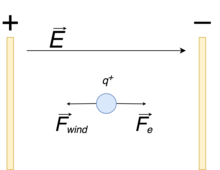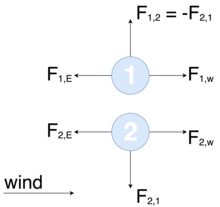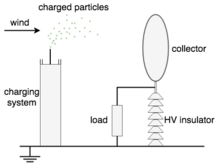Vaneless ion wind generator
A vaneless ion wind generator or power fence is a device that generates electrical energy by using the wind to move charged particles across an electric field.
| Part of a series about |
| Sustainable energy |
|---|
 |
| Overview |
| Energy conservation |
| Renewable energy |
| Sustainable transport |
|
Ion wind generators are not commercially available, though working prototypes and proofs of concept have been created. Several prototypes exist in the Netherlands, one of which resides in Delft University of Technology, whose researchers developed some of the underlying technology.[1] Ion wind generators are currently experimental, while conventional wind turbines are the most common form of wind energy generation.[2] But ion wind generators, which have no moving parts, could be used in urban settings where wind turbines are impractical due to vibrational noise, moving shadows, and danger posed to birds.[3]
History
Lord Kelvin's Thunderstorm
One of the earliest examples of electrostatic energy generation is found in Lord Kelvin's Thunderstorm, a device invented in 1867. Similar to ion wind generators, the Thunderstorm used water to carry charges and generate energy through related principles. However, the Thunderstorm relied on the force of gravity and two oppositely charged reservoirs to generate a voltage difference.[3] Though they are not identical in operation, Lord Kelvin's Thunderstorm demonstrates the behavior of water and concepts of electrostatics that underpin modern ion wind generators.
Design and construction
Theoretical operation

Ion wind generators use the force of the wind to move charged particles, typically water, against the force of an electric field. This increases the potential energy of the particles, which can be likened to moving a mass upwards against the force of gravity. The method of collecting the energy varies by implementation.
The design of ion wind generators eliminates the intermediate conversion of mechanical energy undergone in wind turbines. Wind turbines use the kinetic energy of the wind to rotate several blades about a rotor. The rotor's mechanical energy is converted into electrical energy by an electric generator.
Conversion between different forms of energy necessitates some energy loss, either to the environment or in a useless form, and fewer conversions improve theoretical output.[5]
Simplified analytical model
Researchers from Delft University of Technology devised an equation to model the behavior of the water droplets as they move through the air in order to optimize the system mathematically and run computer simulations. For the purposes of the model, a simple electrode configuration and uniform electric field is assumed, wherein the electric force exerted on the particles will be directly opposite that of the wind.

Each particle is acted upon by the force of gravity,
where is the mass of the ith droplet and is the gravitational acceleration of Earth. The model assumes is constant and does not take evaporation into account. The atmosphere also exerts a force in the form of buoyancy as the droplets fall,
where is the volume of the droplet and is the air density. The droplets are also acted upon by the wind,
where is the drag coefficient, is the wind speed, and is the droplet speed. The equation may be simplified in cases of laminar flow, which can be expressed using the Reynolds Number (Re), which is used in fluid mechanics to determine flow patterns. The flow is considered laminar when the Reynolds Number is less than 1,
where is the viscosity of air. When the flow is indeed laminar, the drag force can be calculated using Stoke's law,
where is the Cunningham slip correction factor, which is assumed to be 1 for particles greater than 1μm in diameter.
The electric force acting on the droplets is affected by both the external electric field () of the device's electrodes,
where is the charge of the ith droplet, and the electric fields of other charged droplets,
where is the distance between droplet i and droplet j. The sum of these forces represents the researchers' full equation,
where is the total force exerted on the ith droplet and is the acceleration of the ith droplet. The work done on the ith droplet can be calculated using the previous equation,
where is the droplet's displacement. The researchers use this to calculate the potential energy difference for the droplet. The sum of work done on each droplet yields the total energy generated from the wind.[4]
Implementations
There are two mainstream implementations of ion wind generators. The first, patented by Alvin Marks in 1977, was a twofold device comprising a charging system and separate collector. The EWICON is a derivative of the design that allows the system to function without the need for a separate collector.
Alvin Marks' patent

A grounded charging system produces a cloud of charged particles. The wind carries the particles toward an insulated collector. Though the collector is initially neutral, the particles transfer their charge upon contact, increasing the collector's potential energy.
The charged particles and the collector, now also charged, form an electric field which exerts a force on the particles in the opposite direction of the wind. Though the force of the wind initially exceeds the force of the electric field, the continuous flow of particles increases the force of the electric field. The force may become strong enough to move the particles back towards the charging system, or they may simply pass by the collector. The particles which never reach the collector do not contribute to the net energy generation.
The system performs at maximum efficiency when all particles reach the collector. Adjusting variables such as wind speed and collector size can improve the performance of the system.[4]
EWICON (Electrostatic Wind Energy Converter)
The EWICON functions using the same principles as the previous implementation, but abandons the collector. Instead, the EWICON is insulated from the Earth, and releases charged particles into the air. The dispersal of negatively charged particles from an initially neutral system increases its potential energy. Once the charging system has a polarity, which is opposite to that of the particles, an attractive force is exerted. If there is little wind, the force may transport the particles back to the charging system, losing the net energy gained from their dispersal.
The EWICON system performs at maximum efficiency when all particles leave the charging system and reach the Earth, which acts as the collector in lieu of a secondary system.[4]
A group of researchers from Delft University of Technology devised the system. One prototype of the device was installed on the university campus, and two more sit atop the Stadstimmerhuis 010 building located in Rotterdam. The prototypes were designed by Mecanoo, a local architecture firm in Delft.[1]
The Dutch Windwheel
The Dutch Windwheel is a building design that is expected to incorporate EWICON technology. The plans were proposed by a partnership of three Rotterdam companies through the Dutch Windwheel Corp., who expect the building to be completed by 2022. The structure is intended to display multiple environmentally-friendly technologies, including rainwater capture, wetland water filtration, and solar energy. The center of the circular building is reserved for wind power generation through the use of a large-scale ion wind generator based on the EWICON implementation. The efficiency and power generation of the system at such a scale is not known, but the Dutch Windwheel Corp. expects the building to generate more energy than it consumes.[6][7]
Comparison with wind turbines
Ion wind generators and wind turbines share some of the same advantages and disadvantages. Both are subject to the conditions of the wind, and are unable to generate electricity if the weather conditions are not favorable. This can be mitigated to some degree with strategic placement of the devices in areas with more consistent wind speed.[8]
Advantages
Ion wind generators are typically much smaller than wind turbines. Many wind turbine models exceed 400 feet (122 m) in height.[9] Their size and complexity lead to high maintenance costs, which, when combined with the cost of operation, may account for a quarter of the total cost per kilowatt-hour.[10] Wind turbines also produce noise which may disturb residents in the vicinity.[11] The aerodynamic properties of wind turbine blades[11] and inner mechanical workings[12] produce the noise, yet both features are not present in ion wind generators. Quieter operation has led researchers to consider using the technology in urban environments. The bladeless design of ion wind generators could make wind power more environmentally friendly, as current "wind power plants represent a risk of bird mortality."[13] Wind turbines have maximum speeds of operation which vary by design. Wind turbines shut down when "cut-out" speeds are exceeded to prevent damage.[14] Therefore turbines are unable to generate energy in high speed winds which fall beyond the window of performance, while ion wind generators can theoretically continue to operate.[15]
Disadvantages
The technology is still in its nascence, and ion wind generators are not as efficient as conventional wind turbines. During tests conducted in 2005, the EWICON was unable to match wind turbine output. Researchers were able to demonstrate "a conversion of 7% of the wind energy into electrical energy, whereas conventional wind turbine systems have an efficiency of 45% at their rated speeds. Improvements are suggested that could lead to an efficiency of the EWICON in the range of 25–30%."[15] At the 2005 International Conference on Future Power Systems, suggestions for future advancements included changes to the method of electrohydrodynamic atomization, or electrospray, and designing a more dense array of nozzles.[15] Tests have yet to indicate that the technology has developed enough to rival wind turbines in efficiency. Several prototypes have been built for testing and experimentation, but researchers hope to build a larger device with greater power output.[16] While the current level of development does not surpass wind turbines in efficiency, the technology could contribute to the energy mix in urban environments where a wind turbine may be impractical.
See also
References
- "EWICON bladeless wind turbine generates electricity using charged water droplets". newatlas.com. Retrieved 2018-10-17.
- ClimateWire, Umair Irfan. "Do Alternative Designs for Wind Turbines Work?". Scientific American. Retrieved 2018-10-17.
- The London, Edinburgh and Dublin Philosophical Magazine and Journal of Science. Taylor & Francis. 1867. p. 391.
- Dhiradj., Djairam (2008). The electrostatic wind energy converter : electrical performance of a high voltage prototype. [S.l.]: [s.n.] ISBN 9789085594826. OCLC 839641603.
- "Energy loss - Energy Education". energyeducation.ca. Retrieved 2018-10-31.
- Waerden, Rodesk | Jasper Rooduijn & Bart van der. "The Dutch Windwheel". dutchwindwheel.com. Retrieved 2018-11-03.
- "The Dutch Windwheel - circular wind energy converter". www.altenergy.org. Retrieved 2018-11-03.
- Rodman, Laura C.; Meentemeyer, Ross K. (2006-10-01). "A geographic analysis of wind turbine placement in Northern California". Energy Policy. 34 (15): 2137–2149. doi:10.1016/j.enpol.2005.03.004. ISSN 0301-4215.
- Watch, National Wind. "National Wind Watch | Size of Industrial Wind Turbines". National Wind Watch. Retrieved 2018-10-15.
- "Operation and maintenance costs of wind generated power". www.wind-energy-the-facts.org (in French). Retrieved 2018-10-15.
- 1937-, Wagner, S. (Siegfried) (1996). Wind turbine noise. Bareiss, R. (Rainer), 1965-, Guidati, G. (Gianfranco), 1968-. Berlin: Springer. ISBN 978-3540605928. OCLC 34546907.CS1 maint: numeric names: authors list (link)
- Krishnappa, G. (1984). "Noise and Vibration Measurements of 50 kW Vertical Axis Wind Turbine Gear Box". Noise Control Engineering Journal. 22 (1): 18. Bibcode:1984NCE....22...18K. doi:10.3397/1.2827623. ISSN 0736-2501.
- Barrios, Luis; Rodríguez, Alejandro (2004-02-12). "Behavioural and environmental correlates of soaring-bird mortality at on-shore wind turbines". Journal of Applied Ecology. 41 (1): 72–81. doi:10.1111/j.1365-2664.2004.00876.x. hdl:10261/39773. ISSN 0021-8901.
- "How Do Wind Turbines Survive Severe Storms?". Energy.gov. Retrieved 2018-10-15.
- "The development of an electrostatic wind energy converter (EWICON) - IEEE Conference Publication". doi:10.1109/FPS.2005.204208. Cite journal requires
|journal=(help) - "EWICON bladeless wind turbine generates electricity using charged water droplets". newatlas.com. Retrieved 2018-10-15.
Patents
- U.S. Patent 4,433,248: Charged aerosol wind/electric power generator with solar and/or gravitational regeneration (Alvin Marks)